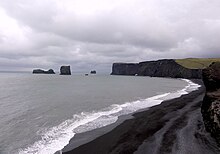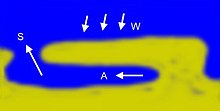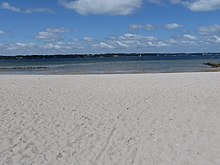Beach

A beach is a flat strip of coast or shoreline made of sand or rubble .
A beach made of coarse-grained to fine sand in different colors is called a sandy beach. Most of the time these beaches are brownish or white. There are also beaches of black (on volcanic islands) and (very rarely) pink sand.
In contrast to beaches made of gravel or rubble (stone beach), (especially white) sandy beaches are an important feature for holiday resorts and holiday hotels. Sand dunes are often found on sandy beaches .
Formation of beaches
Beaches are mostly located on a coast to the sea or form the bank of a river and are therefore subject to the influence of the water current. Sand or stone can be washed up on beaches or removed from the land. Beaches where sand washes up usually have wide sandbanks. In the degradation area of the ocean current, beaches are characterized by a slight gradient towards the sea.
The sandy beach of the North Frisian island of Amrum is located in the wash-up area on the German North Sea coast . This strip of sand, known as Kniepsand , is geomorphologically a sandbank connected to the west of the geest core of the island , and with a width of almost two kilometers is one of the widest sandy beaches in Europe. The beach on the neighboring island of Sylt is being dismantled and shows a considerable loss of land every year. This process is counteracted by pre-washing sand by sucking sand from the seabed with dredgers and washing it back to the beach via pipelines.
Many sandy beaches on the Mediterranean Sea are also suffering from loss of area . The reduction is due, on the one hand, to the fact that people - with the intention of creating more beach area - leveled the plant-covered dune landscapes into a flat beach without vegetation and consequently started erosion . The second cause of beach shrinkage is global warming , which causes sea levels to rise, which in turn gradually erodes the sand. A third cause that has so far been neglected is the ongoing degradation of sand from rivers and seas. While the sand from the rivers was able to guarantee a natural supply for a long time, a shortage has arisen today. The reason for this is, on the one hand, the dams that hold back the sand, on the other hand, the digging of sand directly from the rivers (this has largely been abandoned due to the increase in flooding that this resulted in). However, the extraction of sand from the sea, especially near the coast, has much more serious consequences. Because once the sand has been removed at one point, new sand begins to slide in. And so it happens that entire beaches, now even entire islands, are disappearing. One example is the “Schickeria-Strand” Macchiatonda near the Tuscan Capalbio , which was around 50 meters wide in 1975 and only 10 meters wide in 2005 (due to the factors mentioned).
Beaches used for tourism are partly filled with fresh sand, for example on Mallorca or Gran Canaria . The sand for this is procured from Western Sahara , among others . On Madeira , artificial beaches with sand from Morocco were created in Calheta and Machico . Sand has been shipped on Sylt since the 1970s.
The buildings in the immediate vicinity of the beach also have a major impact on the erosion that affects the beaches. For example, the “freedom of movement” is restricted and the sand cannot pursue its natural hiking sequence unhindered, which means that the sea is offered an increased attack surface and the beach begins to dwindle.
Baltic Sea beach crossing on Darß
Secluded beach in southern Croatia
Beach in Ko Lanta , Thailand
The Myrtos beach on Kefalonia is "framed" by two mountains.
Klein Bonaire Beach, Curacao
Beach in south west Brittany
Surf backflow

Water waves break on the beach at an average water depth that roughly corresponds to the wave height. With a sideways current, the surf shifts the sand and washes a groove between the area of breaking waves and the shore. You first have to walk through a deeper area from the beach to get to the waves.
In the picture on the right it is ebb . The sandbank and the groove open on one side are clearly visible. At high tide, the sandbar is flooded. In the schematic drawing, W denotes the incoming waves. The water does not run evenly, but follows the groove A . The cross current is superimposed at the outlet to form a current S , which flows away from the beach, the surf return current . When the waves are high, it is difficult for swimmers to get to the beach within such a zone. In this case you should swim parallel to the beach and try again in other places.
tourism
Many people spend their summer vacation on sandy beaches. As a destination for mass tourism , beaches often offer a variety of opportunities for relaxation and sports. Swimming , sunbathing , beach sports such as beach volleyball and beach soccer or walks on the beach promenade are examples. On nudist beaches , this is also common and accepted without clothing. One of the many attractions, especially for children, is the building of sandcastles and other structures. The typical beach chairs are set up in places on the German North and Baltic Sea coasts .
In travel catalogs , the length and width and the distance to the hotel are usually given as quality criteria. "Natural beach" means, for example, that the sand is not cleaned there. The sandy beach is an important postcard and photo motif , often used as a backdrop , especially in advertising .

See also
Web links
Individual evidence
- ^ Conflict beach taking shape in Canary Islands. In: wsrw.org . December 4, 2019, accessed February 5, 2020.
- ↑ Playa de Tora beach - artificially raised beach in the city of Peguera . In: lebhaftes-mallorca.com , accessed on February 5, 2020.
- ↑ The end of the beaches . In: derstandard.at , July 14, 2018, accessed on February 5, 2020.
- ↑ Markus Roman: These beaches come from human hands . In: t-online.de , June 21, 2012, accessed on February 5, 2020.












